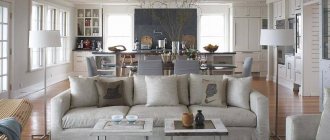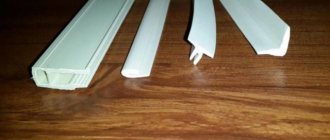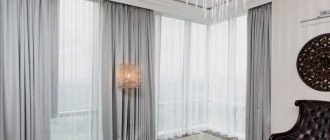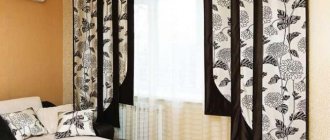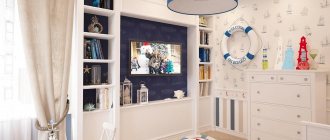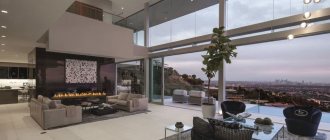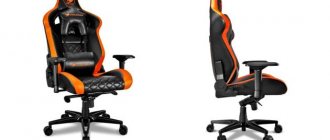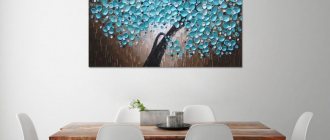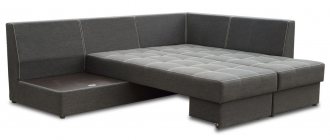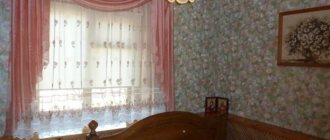Fabric-covered beds: types and features
Options for beds upholstered in durable high-quality textiles fit perfectly into any interior: classic or modern. The entire variety of choices is based on 2 main types:
- completely fabric;
- wooden/metal with fabric headboard.
Features of modern models:
- The soft back protects against the cold wall.
- The variety of upholstery allows you to choose color and texture.
- Various sizes and shapes of the headboard make it easy to fit into any design.
- The ability to adjust the headboard, inherent in many models.
Fabric beds can be either with or without a lifting mechanism.
Full fabric
These are designs with a soft headboard and sides covered with fabric. The frame is made of solid materials. Synthetic or natural fillers are used for the base of the soft part. For the finishing of soft parts, foam rubber or synthetic winterizer is used. When all the components are ready, they are covered with fabric.
As a result, such a bed always has a strong solid frame and an external soft surface and looks very presentable.
Wooden/metal with fabric headboard
These models are closer to the traditional version, when the base and sides are hard, and the headboard is soft, covered with various types of fabric (may also contain filler).
For such beds, the base material and sides are usually made of:
- natural wood;
- plywood;
- MDF;
- chipboard;
- metal
Natural wood has the highest environmental friendliness. The metal frame is the most reliable design. It is mounted on a bed frame made of wood or on metal legs standing on the floor.
Soft fabric headboards delight you with the choice of:
- stationary attachment to the bed base is part of it;
- attached. It is a separate block, can be a shelf or a screen;
- mounted. It is used more often for decorative purposes.
How to upholster with fabric: master class
Below we discuss upholstery methods for different headboard options, as well as different upholstery methods.
Large rectangular
A rectangular headboard is the easiest to restore and decorate. It is enough to choose the fabric for the upholstery, as well as stock up on foam rubber and padding polyester. Instructions:
- place the backrest on the foam rubber, cut around the perimeter;
- Apply construction adhesive to the headboard and press down the foam;
- At the top end, sew the foam rubber with a stapler;
- lay the padding polyester with an allowance of 7–8 cm at the edges;
- lay the upholstery, tuck the edges with padding polyester from the top, and staple to the base;
- Sew the bottom end in the same way, fix the fabric on the sides;
- cut triangles of fabric at the corners and secure with a stapler.
This finishing option is the simplest. It is enough to monitor the tension of the fabric so that there are no ties or distortions. If possible, ask a friend for help.
Figured
Upholstering a shaped headboard is a little more difficult, but only because it will take more time. The procedure is no different from standard upholstery, but has a number of features:
- the foam rubber must be cut to the shape of the headboard (curly), so it is more convenient to use tailor’s scissors instead of a stationery knife;
- padding polyester or batting is also laid on top of the foam rubber, which is fixed along the contour of the part with a stapler until the required shape is achieved;
- the lower end of the back is usually straight, so start from there: lay the fabric on the lining, stitch with a stapler from the back side;
- do the same with the sides, cutting off the fabric in the lower corners - only the upper curly end will remain to be covered with fabric;
- act progressively: place staples through every centimeter of fabric, make cuts in places of bends so that the upholstery is more pliable;
- after covering, the back side of the back will look unaesthetic: this can be corrected by sewing mesh lining fabric or any other fabric.
Advice
Stock up on anti-stapler in advance. When working with a shaped headboard, you will often need to remove the brackets to adjust the upholstery.
Angular
There are different ways to use the free space in a room. Often the bed is placed in a corner to free up space. These can be either regular rectangular beds or corner models. Here it is reasonable to stylize the corner as a sleeping place, designing a corner headboard for better positioning of the sleeping area.
Peculiarities:
- you will need to measure the width and length of the bed to determine the angle parameters for decoration;
- Based on the parameters of the bed, prepare two plywood, chipboard, fiberboard or a pair of wooden panels (longitudinal and transverse);
- in the case of standard upholstery, it is enough to reupholster the sheets by covering the sheets with foam rubber, padding polyester and fabric;
- for the carriage screed, diamond-shaped markings are made on plywood;
- at the intersections of the diamonds, holes are drilled to adjust the fittings and fabric;
- You can secure the plywood to the wall with screws, bolts, nails or a profile;
- To increase the strength of the structure, glue is used in corner joints (preferably epoxy).
Attention
A corner headboard will likely require drilling into the wall. It is irrational to attach such a headboard to the bed because of its heaviness.
With decorative trim
Products covered with leather or fabric are usually decorated with decorative nails or rivets. This headboard takes on a finished look and looks aesthetically pleasing. The main constriction is carried out according to the general principle. Markings for future decor should be done on the finished back, which is covered with fabric.
- Make the necessary indentation along the edges. To do this, it is convenient to use a triangular ruler.
- Use a pencil to mark the places where the outermost nails will be driven in.
- Install the nails and stretch a thick thread between them.
- Measure the width of the marking: this way you will understand at what step it is better to install the fittings.
- Mark with a pencil all places for installing parts.
- Then you just need to install the nails according to the markings and hammer them in with a hammer.
Reference
Upholstery with decorative trim looks good on both rectangular and shaped headboards.
Sheathing with carriage tie
The carriage tie is most popular when covered with leather. However, the quilted effect can be achieved even with the help of other upholstery fabric. Additional accessories and tools will be required: decorative buttons, round drill. Instructions:
- cut the foam around the perimeter of the back, glue it with mounting glue;
- wait until the glue sets (5–7 minutes), turn the part with the foam over;
- Use a pencil to mark under the screed, keeping 5–7 cm margins along the edges;
- Drill holes at the intersections of the diamonds: this is where the fittings will be installed;
- to draw holes on the foam rubber, remove the needle and thread and make a mark;
- drill holes in the foam using a round drill;
- fix the padding polyester with a stapler, make indentations in the holes (press your fingers on the padding polyester at the drilling sites);
- Apply identical markings to the reverse side of the leather, thread the threads where they align with the holes;
- lay the skin on the foam rubber, pull the threads through the holes and pull it tight, fix it on the back side with a stapler;
- stitch the leather along the edges of the headboard, starting from the top end and ending with the sides;
- Thread the threads into the legs of the buttons, pull them out into the holes on the headboard, and sew them on the back side with a stapler.
Attention
The thickness of the foam rubber for the carriage screed must be at least 50 mm. It is not necessary to lay synthetic padding under natural leather, but it is recommended.
The video shows how to cover the headboard with a carriage screed:
How to make upholstery on the back side?
- A mesh lining fabric (perforated) of the desired shade is attached to the back side of the headboard. It hides the aesthetic imperfections of the covering, protects the wood and joints from damage. It is necessary to cut the fabric with 2-3 cm indentations along the edges of the headboard so that there is enough of it to cover the stitching.
- Fold the edges and secure with pins for convenience.
- Secure the material with a stapler around the perimeter of the back.
- Alternatively, the fabric is secured with small nails. Then the seam seems neater.
Upholstering a headboard is easy to do and the results will bring joy to any bedroom owner. You can revive old furniture, create a unique thing that has no analogues. To do this, you will need a minimum of tools and the help of a close friend, because any work moves faster in a team.
Advantages and disadvantages
In addition to a restful sleep on comfortable and aesthetically pleasing beds with fabric upholstery, they have significant advantages:
- Safety. Such designs take root well in children's bedrooms.
- High wear resistance of textile coating.
- Endless variety of color preferences.
- Practical to use.
- Length of service life. If the damage is significant, the textiles can be easily replaced.
- Durability of any base.
The disadvantages of beds with textile upholstery include the following:
- in a design with a stationary headboard, it can be difficult to clean the upholstery or change it;
- Some natural types of fabric quickly wear out and lose color. Synthetics last a long time, but do not allow air to pass through well and accumulate static.
Types of sofas
The price of partial restoration (upholstery) primarily depends on the degree of wear, complexity of the model and type of sofa. Most common types:
Corner sofas are increasingly gaining popularity; they are convenient for simultaneously accommodating several people at once. They often have soft fabric armrests, which will also be taken into account when upholstering. The parameters of modular and island sofas are similar to corner sofas, in contrast to compact and economical double sofas.
replacement of the filling of soft parts is taken into account as necessary . A lot will depend on its quality - the service life of the upholstery with even load distribution, comfort, and presentability. Modern furniture manufacturers most often use PPU filler - polyurethane foam, or the classic version - spring sofas. An external inspection assessment will determine the need for this replacement.
Fabrics used as bed upholstery
Upholstery fabrics are divided into natural, synthetic and artificial according to their composition. For better practical results, different fibers are often combined or all 3 types are used at once.
Gozhka
Furniture matting is made from natural fibers (wool, silk, linen, cotton). It has a checkerboard weave pattern and its smoothness, brightness or hairiness depends on the ratio of different types of threads.
This furniture material is characterized by:
- resistance to abrasion and mechanical damage;
- softness and pleasantness to the touch;
- ease of care;
- good breathability;
- environmentally friendly and hypoallergenic;
- versatility and aesthetics.
Velours
Velor material is obtained by weaving 2 pairs of threads for the lower and upper base and pile. It is made mainly from natural and artificial fibers and is considered optimal for upholstering complex furniture structures.
Consumer properties of velor:
- reliability and long service life;
- color fastness;
- pleasant softness thanks to the pile;
- immunity to many types of pollution;
- Possibility of dry cleaning.
Chenille
Chenille fabric is made on special machines that create a dense, velvety fabric based on satin, tapestry or jacquard weaving. There are 3 types of chenille fabric: natural (cotton), artificial (cotton and viscose), synthetic (polyester).
General properties of this type of textile:
- high strength;
- breathability and hygiene of the material with cotton;
- color stability;
- delicate velvety;
- decorativeness;
- cleaning without aggressive agents.
Chenille is often used for upholstery of furniture (mainly sofas), blackout curtains and bedspreads.
Microfiber
Microfiber furniture fabric consists of polyester and nylon, has a huge number of micropores, and this feature brings its properties closer to natural fabrics while maintaining the undeniable advantages of synthetics. Its unique properties:
- high density and durability;
- hypoallergenic and breathable;
- color fastness;
- moisture resistance;
- possibility of washing and cleaning;
- antifungal effect;
- soft to the touch.
Photo: Double bed upholstered in fabric
Flock
Flock is widely used for furniture upholstery, mainly due to its low price. This is a non-woven textile that is produced by gluing pile from waste from the production of wool, cotton and synthetic threads to a base on one side. The base can be natural (cotton) or synthetic (polyester).
Its characteristics:
- wear resistance, strength;
- moisture resistance;
- attractive appearance;
- resistance to abrasion and deformation;
- electrification;
- prohibition of cleaning with chemicals.
Eco leather
Ecological leather (eco leather) is a new modern material made of cotton coated with polyurethane without harmful impurities.
Main qualities:
- environmentally friendly, hypoallergenic and safe;
- high wear resistance of the material;
- similarity to natural leather;
- smoothness;
- breathability and hygroscopicity;
- no unpleasant odor;
- ease of care.
Advantages and disadvantages
Flock has the following advantages:
- increased density, and therefore strength. A flock product is difficult to tear or damage;
- water resistance. The material perfectly repels moisture;
- waterproof. Particularly relevant for mixed types of flock;
- wear resistance. Flock does not wear out over time, does not become covered with pellets, does not shrink or stretch;
- resistance to temperature changes;
- softness. The products are pleasant to the touch;
- good aesthetic characteristics;
- ease of cleaning and maintenance;
- ease of coloring, which is why flock sofas can have a wide variety of colors.
There are some disadvantages:
- electrification. Flock furniture easily attracts dust and debris;
- flock does not tolerate products that contain alcohol. They contribute to damage to the canvas;
- Some types of material wrinkle easily.
Photo: Flock sofa with Eurobook folding mechanism
Which fabric is best for bed upholstery?
When choosing upholstery fabric for a bed, it is not enough to rely only on your own taste. It is better to understand the characteristics of the various options and compare them. It is important to consider the conditions in which the bed will stand. Each person may have their own priorities in the properties of the fabric, not least of which is the price. Typically chosen based on appearance, durability, functionality, style, design, feel, and ease of care.
A bed with soft textile upholstery is always an island of comfort in the home. A correctly selected design will decorate any bedroom interior. You simply cannot find a better place for good sleep and relaxation!
Variety of fabrics
Modern flock is quite variable. The material can be soft or hard, different in thickness, thickness of the top layer, etc. The determining role in this is played by the pile, or more precisely:
- thickness;
- length;
- density (frequency of spraying).
Color options are not limited.
Nowadays, new unusual flock fabrics have appeared. Among them:
- Aramid. It is distinguished exclusively by yellow color. The application is highly specific.
- Carbon fiber flock. It is characterized by absolute non-flammability (without special processing required for other types). More expensive than other flock fabrics.
Rule No. 2. Upholstery must match the purpose of the room
The range of furniture upholstery manufacturers is unusually wide and includes various types of textiles. Fabrics with soft pile and beautiful texture provide a pleasant tactile sensation, but require maintenance, and are therefore more suitable for residential areas. For commercial purposes, experts advise purchasing practical material with a smooth surface and a Teflon protective layer. And in order to better navigate the world of fabrics, you need to learn more about them.
Fabrics with soft pile
Upholstery with soft pile is an excellent choice for living rooms, bedrooms, and children's rooms. It can be either woven or non-woven, but in any case, these materials can create the most comfortable atmosphere in the room.
- Chenille is a textured textile with a characteristic soft surface, very durable and wear-resistant. It is made from pile yarn, which consists of two threads twisted in a spiral with fibers woven between them. This technology provides the textile with special strength, and the use of bouclé and melange threads in the production makes it possible to obtain denser and very beautiful samples.
- Flock is a modern interpretation of expensive velvet, made using the appliqué method. This is a non-woven material with a durable base, onto which nylon or polyamide fibers are applied using a special glue. Flocks are mostly vandal-proof materials, last a long time and are easy to clean.
- Velor (micro-velor) is a durable fabric with an expensive matte sheen, dense, short and soft pile (cut or looped). It can be vertical, lying to one side or embossed. Velor is obtained by weaving 5 threads and is highly wear-resistant.
- Microfiber, which is made from ultra-thin polyester fibers, belongs to the new generation of furniture textiles. It is UV resistant, does not pill, does not fade, can be plain or printed and is suitable for any models of upholstered furniture. And the most interesting look is fabric with a laser pattern applied to the surface.
- Artificial suede is an imitation of natural suede with excellent performance characteristics. It contains cotton and polyester, making the material environmentally friendly and durable. And the Teflon coating reliably protects the fleecy surface from stains.
Lint-free textiles
Upholstery with a lint-free surface is an excellent option for both home and commercial furniture. It doesn’t matter what textile you prefer: with or without an expressive texture.
- Eco-leather is visually practically no different from natural leather, but is cheaper and does not require constant attention. It is available in a wide range of colors, can be smooth, or can have the texture of ostrich, bison or reptile skin.
- Matting is one of the most popular furniture fabrics due to its versatility. The threads intertwined in a checkerboard pattern give it an authentic look and similarity to noble linen or charismatic burlap.
- Jacquards are mixed fabrics with complex longitudinal-transverse weaving and woven or printed patterns. Such textiles look very expensive and boast excellent density and softness, but require attention and can only be dry cleaned.
- Tapestry is a type of jacquard. This is a single-sided material with cross-weave threads. A characteristic feature of tapestries is their complex design with multi-color woven patterns or ornaments.
Extend the life of furniture with proper care
Contamination is often caused by accident - coffee was spilled, berry juice dripped, or the dog got in with dirty paws. After such troubles, you need to clean the entire sofa, or a small section of it. A few tips will make this process easier:
- Regular cleaning with a vacuum cleaner will prolong the fresh look;
- the upholstery should not be wetted too much, because it does not dry well;
- with strong brushing, some furniture fabrics pill and lose their appearance;
- You should especially pay attention to the seams and places where buttons are attached, because this is where the main dirt accumulates;
- A weak soap solution copes well with dirt;
- tea and coffee stains are removed with a vinegar solution;
- Stains are removed from the skin with a damp cloth.
A short video with tips on what upholstery to choose if you have a cat at home:
Reupholstering a sofa at home and in the workshop
While many workshops offer a free visit of a specialist to inspect and take measurements, there is a service for restoring sofas at home. It is offered at the request of the client or if transporting the furniture is difficult. Working from home takes longer, this is probably the only difference, and the payment is calculated similarly to reupholstery in a workshop - the price of services plus the price of materials and the cost of additional costs. A paid call to a specialist for measurements costs from 300 rubles and more .
Sofa repairs are carried out in modern workshops or studios equipped with all tools and special equipment. You can find addresses on the Internet. Before making your choice, read reviews, view completed work, study prices and range of services. Do not rely on the advice of random people; choose a reliable service provider with many years of experience. It is important that the result of the work is no worse, and even a little better, than planned.
Let's summarize - the exact price for the service of upholstering a sofa with fabric will be calculated individually, taking into account all the characteristics of upholstered furniture and its dimensions. You can use materials and accessories suggested by experts or try to prove yourself as a designer by creating your own color and texture solution - the updated sofa will be unique.
Factors influencing prices
When replacing the upholstery of a sofa, you can do a full or partial reupholstery, in this case the price of repairs ranges from 2500-9000 rubles . Replacing the filler may also be incomplete; foam rubber or more technologically advanced and wear-resistant materials are used. In this case, the cost of services is estimated at 4,000-15,000 rubles . Urgency of the order is paid additionally, based on the percentage established by the studio.
When purchasing upholstery fabric, you can take the advice of experts or choose it yourself, focusing on your taste and preferences. velor , chenille , matting , tapestry or jacquard are usually chosen . The properties of these fabrics include resistance to mechanical damage, they retain their original appearance for a long time and look aesthetically pleasing.
